Rajasthan Board RBSE Class 11 Biology Chapter 28 Origin of Life and Organic Evolution
RBSE Class 11 Biology Chapter 28 Multiple Choice Objective Questions
Question 1.
Philosophic Zoologique is written by
1. Darwin
2. Lamarck
3. Weisman
4. Wallac
Question 2.
Homologous organs are
1. Similar in origin, different in function
2. Different in origin, similar in friction.
3. Similar in both origin & function.
4. Different in both origin & function.
Question 3.
Which is not a set of homologous organs
1. Wings of bat, bird & butterfly
2. Wings of birds & hand of man
3. Wing of bat & forelimb of man
4. Wings of bird & flippers of whale
Question 4.
Which of the following structure is not vestigeal in man
1. Nictitating membrane
2. Ileum
3. Pinnae muscles
4. Vermiform appendix
Question 5.
The scientist associated with Galapagos island
1. Malthus
2. Darwin
3. Wallace
4. Lamarck
Question 6.
Which one is a connecting link
1. Archaeopteryx
2. Neoceratodus
3. Darwin’s finches
4. Drosophila
Question 7.
The most perfect evidence of evolution
1. Vestigeal organ
2. Comparative study
3. Comparative embryology
4. Fossils
Question 8.
Article “population theory ” was written by
1. Lamarck
2. Weisman
3. Malthus
4. H. de Vries
Question 9.
Who propounded pan genesis theory
1. Darwin
2. Oparin
3. Lamarck
4. H de Vries
Question 10.
Factor responsible for origin of species
1. Isolation
2. Mutation
3. Hybrid
4. All
Question 11.
Which type of animals are selected by nature in “Natural selection”
1. Most adapted
2. Weak
3. Wild species
4. Normal
Question 12.
Which type of variations are useless in the view of evolution
1. Somatic
2. Germinal
3. Continuous
4. Discontinuous
Question 13.
Other name for positive – Negative variations
1. Somatic variations
2 Determinate variations
3. Continuous variations
4. Discontinuous variations
Question 14.
Type of isolation caused by river, mountain desert etc
1. Geographical
2. Habitat
3. Seasonal
4. Physiological
Question 15.
The species of different geographical regions are called
1. Neopatric
2. Sympatric
3. Alopatric
4. Sibling
Question 16.
The primary source for genetical variations is
1. Mutation
2. Recombination
3. Both land
4. None
Question 17.
The process that prevents inter flow of genes is
1. Speciation
2. Adaptation
3. Isolation
4. None
Question 18.
According to Darwin, the origin of species is due to
1. Mutation
2. Natural selection
3. Hybridization
4. Inheritance of acquired characters
Question 19.
In which book Darwin published his thoughts
1. Systema Nature
2. Palaeontology
3. Philosophine Zoologique
4. Origin of species
Question 20.
Scientists who supported Lamarckism
1. Sumner
2. Tower
3. Macderegolus
4. All
Answers :
(1). 2
(2). 2
(3). 1
(4). 2
(5). 2
(6). 1
(7). 4
(8). 3
(9). 1
(10). 4
(11). 1
(12). 1
(13). 3
(14). 1
(15). 3
(16). 3
(17). 3
(18). 2
(19). 4
(20). 4
RBSE Class 11 Biology Chapter 28 Very Short Answer Questions
Question 1.
Give one-one example for homologous and analogous organs.
Answer :
Homologous Organs – Fore Limb of Man, Horse & Birds.
Analogous organs – Wings of Birds & butterfly.
Question 2.
Name the connecting link between reptiles and ‘birds’.
Answer :
Archeopteryx
Question 3.
Name the book written by Charls Darwin.
Answer :
Origin of species by natural selection
Question 4.
The process of sudden changes in the genes or chromosomes is called?
Answer :
Mutations
Question 5.
Name the theory given by Lamarck.
Answer :
Lamarckism
Question 6.
Name the ship which was used by Darwin for Voyage.
Answer :
Beagle
Question 7.
Which plant was used by de Vries for the experiments concerning to mutation theory.
Answer :
Evening prime rose
Question 8.
What is genetic drift?
Answer :
Change in the gene frequency in a population
Question 9.
Give the names of subunits of species.
Answer :
Demes, Race & Sibling
Question 10.
The role of isolation in evolution was first explained by which scientist?
Answer :
Wagner
Question 11.
The migratory birds of which country come to the Ghana birds sanctuary in Rajasthan.
Answer :
Siberia
Question 12.
Natural selection is also called.
Answer :
Dividing reproduction
Question 13.
The variations caused by gene exchange are called?
Answer :
Germinal variations
Question 14.
Give an example of atavism.
Answer :
Vestigial tail in human baby
Question 15.
Dinosaurs were found in which era?
Answer :
Mesozoic era.
RBSE Class 11 Biology Chapter 28 Short Answer Questions
Question 1.
What are vestigial organs? Write four names of human vestigeal organs.
Answer :
The nonfunctional organs in the body are called as vestigeal organs. Such as-Vermiform appendix, Mammary glands in man, Ear muscles, Nictitating membrane.
Question 2.
What is fossil? What is their role in organic evolution?
Answer :
Preserved remains of animals & plants in the layer of the earth crust are called as fossils. The study of fossils is called as palaeontology. The fossils provide direct evidence in support of organic evolution
Question 3.
Compare Lamarekism and Darwinism by taking example of Giraffe.
Answer :
The long necked giraffes evolved from ancestors having short height & short neck and were feeding grass. As a result of environmental changes, the grass vegetation is lost & the number of trees is reduced. The continuous stretching of neck & fore limbs by their ancestors to catch (feed) high located leaves of the desert plants caused elongation of the neck and the fore limbs have become longer than the hind legs.
Question 4.
Why the variations are called as raw material for evolution.
Answer :
The variations are called as raw material for evolution because they are the main & progressive factors of evolution.
Question 5.
What do you mean by Neo Darwinism?
Answer :
Neo Darwinismwas strongly supported by Wallace, Davenport, Waldane etc
New-Darwinism includes following 5 series-
- Gene mutation
- Changes in the number of structure of chromosomes
- Genetic recombination
- Natural selection &
- Reproductive isolation
Question 6.
Differentiate homologous and Analogous organs.
Answer :
| Differences between Homologous & Analogous organs | |
| Homologous organs | Analogous organs |
| 1. The body organs which are similar in origin, but may have different function. | 1. The body organs which are similar in function but have different origin. |
| 2. Their basic structure is similar | 2. The basic structure is different. |
| 3. Their function may be similar or different | 3. Their function is similar. |
| 4. Examples – Fore limb of man , horses, whale. | 4. Examples – Wings of birds, bat, insects etc |
Question 7.
Which facts are included in the modem concept of evolution.
Answer :
Charls Darwin (1809 – 1882) put forth a scientific and logical perspectives concern to organic evolution in 1858 – 1859 but at that time the knowledge of genetics was scare. Lateron, many scientists applied genetics in their studies and with the help of Variations, Mutations, Recombination’s, Migration, Natural selection etc put forth the modem view of Darwinism.
Question 8.
What are mutations? Write in brief on types of mutations.
Answer :
The sudden and heritable changes in the animals is called as mutation. They are caused due to change in the genotype of the animal. They can be produce artificially in the laboratory.
They are of three types
1. Gene mutations
2. Chromosomal mutations
3. Genomatic mutations or Polyploidy
Question 9.
Explain concept of species.
Answer :
According to modern concept, species is a group of genetically similar animals that interbreeds to produce fertile offspring. It is a fundamental and smallest unit of classification, but is can be divided into demes, race, sibling etc.
Question 10.
Give a brief account of Isolation.
Answer :
Segregation of the population of a species into small units or strains or subspecies so that they become unable to interbreed is termed as isolation. They subunits become unable to breed with the ancestral species and lead to the formation of new species. This isolation is due to some physical or geographical or other barrier.
Question 11.
Give the factors responsible for speciation.
Answer :
The main factors of speciation are as follows
- Mutation
- Genetic drift
- Migration
- Natural selection
- Sexual-Recombination
- Hybridization
- Isolation
Question 12.
What is polyploidy? What is its importance?
Answer :
Two haploid sets of chromosomes is called as diploid (2N). Presence of more than diploid number is called
as polyploidy such as triploidy (3N), Tetraploidy (4N) etc.
Question 13.
How migration helps in evolution?
Answer :
The addition and deletion of genes by the Immigrants and Emigrants is called as genetic drift. The genetic drift causes changes in the gene frequency of a population which is an important of a population which is an important factor in organic evolution.
Question 14.
How natural selection act in the process of evolution?
Answer :
The fittest are automatically selected. They survived & adapted to the natural environment. The adaptations of the survivors may result in the formation of new structures which are called as variations. The useful and favorable variations were transmitted from generation to generations and led to the formation of new species.
Question 15.
Explain Hardy-Weinberg’s Equilibrium rule.
Answer :
Hardy-Weinberg’s law of genetic equilibrium :
G.H. Hardy (England) and W. Weinberg (Germany) made mathematical expression of the genetics and propound a Hardy – Weinberg’s law. According to it, the gene frequency of a randomly mating large population will remain constant from generation to generation in absence of mutations i.e. this community will remain in genetic equilibrium.
This law further state that the rate of evolution will be zero in the state of genetic equilibrium.
Five factors affect the Hardy-Weinberg’s law
- Gene flow
- Genetic drift
- Mutation
- Genetic recombination
- Natural selection
RBSE Class 11 Biology Chapter 28 Essay Type Questions
Question 1.
What is organic evolution? Give four evidences in the support of evolution.
Answer :
Evidences of Organic Evolution :
The process of evolution is very slow and its results can’t be observed in the life span of man. Study of various branches of zoology provide many evidences in favor of organic evolution.
Evidences from Zoo-geography :
Zoo-geographical distribution of the animals provide evidence of evolution. It has observed some times that the regions of different geographical conditions inhabit similar fauna & flora and the regions of similar climatic conditions inhabit different fauna & flora. It can be explained with help of following examples
- Lung fishes
There are three genera of lung fishes which are found in different continents-
(a) Protopterus-Africa
(b) Lepidosiren -South America
(c) Neocerartodus -Australia
In the ancient time, the Australia & Africa were connected to the Asia by Bering strait and similarly the Africa was connected to the South America. These fishes were found earlier in all these regions but as a result of geographical changes they get confined to specific regions. - Lion and elephant are found only in Asia and Africa, not in America & Australia, and Giraffe, ostrich and Hippopotamus are found in Africa.
- Prototherians & metatherians are found only in Australia, because the Australia continent is isolated from the rest world. In Australia the marsupials remained protected & many new species get evolved . In the rest parts of the world, the evolution of eutherians resulted in the extinction of the marsupials.
- Darwin’s Finches- Darwin studied 20-22 types of birds in the Galapagos Islands situated in Pacific ocean.
They are called as Darwin’s Finches - The species of camel are found in the form of camel in the North America & Asia and in the form of lama in South America.
Evidences from comparative Anatomy :
The vertebrate animals have many similarities like vertebral column. spinal cord, pharyngeal gills slits etc. It indicates that these animals have evolved from a common ancestor. Following organs provide evidence to this fact-
(a) Homologous organs
- The animals of different species have many organs which are similar in origin but they differ in structure. Such as fore limb of man, fore leg of horse, wings of bat. wings of birds and paddles of whale.
- The relationship between the homologous structures is called as homology which is due to common ancestor.
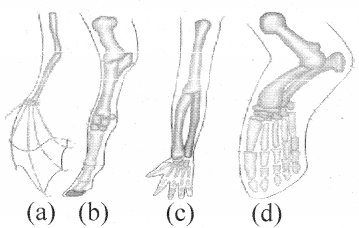
Homology among (a) wing of bat, (b) Fore leg of horse, (c) Fore limb of man, (d) Flipper of whale
Homology is of three types-
- Phylogenetic homology
• The homology which is found in the animals of different species is called as phylogenetic homology. Example – Fore limbs of man. whale, horse & bat. - Serial homology
• The homology in the various organs of the animals of same species on the basis of origin.
Example- Fore limb & hind limb of man; various appendages of prawn etc. - Sexual homology
• The homology found in the male & female of a species is called as sexual homology.
Example- Testes & ovaries of male & female.
(b) Analogous organs
- In many animals different structures perform similar functions & appear to be similar. Such as wings of bats, birds & butter fly
- The wings of bats, pterodactyl, bird & butterfly are used in flight but they have different origin. It is called as Analogy. Such organs are called as analogous organs.
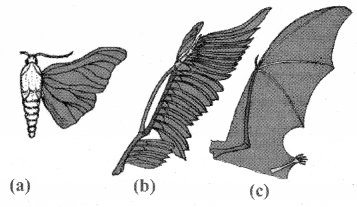
Analogy in (a) wing of insect, (b) wing of bird and (c) wing of bat
(c) Vestigeal organs
- Many animals have various non-functional organs which are called as Vestigeal organs. Such organs were functional but in the course of evolution they gradually reduced & became vestigial.
- Presence of such organs is a direct evidence of evolution.
- There are many vestigial organs in the body of human beings such as-
- Vermiform appendix
It is a well known example of vestigial organ. In other mammals, the vermiform appendix is functional & helps in the digestion of cellulose. The vermiform appendix of man is a vestigial of the functional vermiform appendix of ancestors. - Ear muscles in man is an another example of vestigial organs. In many mammals these muscles are functional & are use in moving the pinnae to receive the sound waves. In human being, they are of no use, hence became vestigeal.
- Presence of 3 to 5 vestigeal caudal vertebrae which are vestiges of well developed tail of other mammals.
- Red colored skin fold in the eyes. It is the vestiges of nictitating membrane of frog, rabbit & cat.
- Presence of pointed canines & 3rd molar and hair on the body
- Mammary glands in man & clitorius in woman.
• Other animals also have vestigial organs. Such as highly reduced pelvic girdles in snakes & whales; reduced wings in flightless birds & siplent bone in the hind legs of horse & deer etc which is vestiges of fibula.
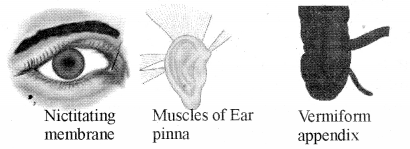
Human Vertigeal Organs
| Differences between Homologous & Analogous organs | |
| Homologous organs | Analogous organs |
| 1. The body organs which are similar in origin, but may have different function. | 1. The body organs which are similar in function but have different origin. |
| 2. Their basic structure is similar | 2. The basic structure is different. |
| 3. Their function may be similar or different | 3. Their function is similar. |
| 4. Examples – Fore limb of man , horses, whale. | 4. Examples – Wings of birds, bat, insects etc |
(d) Atavism or Reversion
It is the tendency to revert to ancestral type. In biology, an atavism is an evolutionary throw back, i.e. as traits (characters) reappearing which had disappeared generation before.
Examples-
- Presence of long & dense hair on the body of some human being (Like apes)
- Some time, small tail is seen in human body.
- Presence of long & pointed canines in same human
babies.
People in the modem era reverting to the ways of thinking and acting of a former time is an example of cultural atavism
Evidence from Paleontology :
Preserved remains of animals & plants in the layer of the earth crust are called as fossils. The study of fossils is called as paleontology. The hard parts of the animals like bones, teeth or shells are preserved in the form of fossils.
Sometimes dead animal before decomposition get buried in the soil and as a result of chemical reactions converts into stone gradually. The near by soil also forms strata by erosion, deposition of sediment in sea, pressure & subsequent upheavals & immersion of land under water. This process is called as petrifaction.
Leonard da vinsci (1452 to 1519) was the first to recognize that fossils provide evidence of life in the past. Darwin showed that fossils are direct evidence in support of organic evolution.
The study of fossils revealed that the dinosaurs were the giant reptiles and they ruled the earth during Mesozoic era. Later on, they get extincted.
Fossils of Archaeopteryx were obtained from the rocks of Jurassic period which is a connecting link between reptiles & birds. It had some reptilian characters like teeth, claws in fore limbs & scales on the body and some features of birds such as beak, feathers on the body & wings. It shows that the birds evolved from reptile-like ancestor.
Scientists have studied the complete ancestry and history of evolution of horse, elephant and man with the help of fossils.
Hence, the fossils provide direct evidence in support of organic evolution
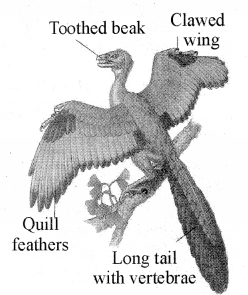
Archaeopteryx
Evidence from comparative Embryology :
Biogenetic law and Recapitulation theory given by Haeckel provide direct evidence of organic evolution. According to it. the embryonic stages of the animals are similar to their adult ancestors. At the time of formulation of recapitulation theory. Haeckel considered following principle of embxyology given by Von Baer-
- During embryonic development general characters appear earlier than die specific characters.
- During development variations in different animals appear slowly.
- The specific features appear in the end of the embryonic development.
- The initial stages of embryonic development are similar in different animals.
According to Muller-Haeckel law. “ ontogeny repeats phylogeny “ i.e. embryonic development of an animal repeats its evolutionary history.
For example, during embryonic development, the human embryo resembles with fish in die beginning, later with amphibians & reptile. In seventh month, the human embryo resembles a monkey.
Adult frog excretes urea but it’s tadpole excretes NH3 like fishes. It is called as bio-chemical recapitulation .The tadpole larva has gills like fishes & human embryo has gill- slits like fishes. It is called as structural recapitulation
The embryonic stages like zygote, cleavage, blastula, gastrula & neurula are basically similar in all animals.
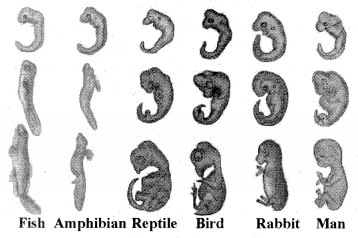
Embryonic stages of various vertebrates
Evidence from Interrelationship among organisms :
There are millions of species of living organisms on the earth. Morphological, they appear to be different but when we study their physiology and chemical composition, a distinct interrelationship among species is seen. All the living beings are made up of cells and every cell performs all the vital activities. The basic structures of the cells of all the species is similar.
The vital activities like respiration, excretion, reproduction, digestion are physiologically similar. All the living beings utilize O2 in respiration & release CO2.
In all the multi cellular organisms, hydra to whale, the life begins from unicellular zygote.
The above evidences reveal a common ancestor for all the living beings .
Question 2.
Interpret Lamarkism & Darwinism.
Answer :
Lamarkism :

(A) General
- Jean Baptist Lamarck was a naturalist of France.
He was professor of Botany in Paris. In 1801 & 1802. he published two papers regarding evolution-
- Systeme des animare sans vertebras
- Researches rural organization des corps vivans.
- In 1809 he described for the first time, the principles of evolution in a book “Philosophic Zoologique”.
- He coined the term ‘‘Biology”.
- He for the first time used the terms Invertebrate & Vertebrate.
- Lamaskism is also called as “Inheritance of Acquired Characters”.
(B) Assumption of Lamarkism
- Lamark put forwarded four hypothesis which are collectively called as Lamarkism –
- Effect of the environment
According to Lamark, the environment affect the morphology of the animals which causes changes in the behavior of the animals. As a result some organs or structure of the animals become abnormally active. - Effect of needs
According to it as a result of change in the requirement some new organ develops in the body of the animals or the structure of the existing organ is modified. - Effect of use and disuse of organs
According to it. if the organs are used frequently and continuously, they are strengthened, developed and enlarged. On the other hand if not used, they get weaken and finally disappear. - Inheritance of acquired characters According to it the favorable characters which are gained or acquired during the life time of an individual are transmitted to the offspring. The cumulative effect of such acquired characters resulted in the origin of new species.
(C) Examples of Lamarckism
- The ancestors of the modern horse were plantigrade, graminivorous & were living on moist soil. Changes in the environment & habitat caused changes in their habits. Now, they had to feed hard & dry grass and they had to run fast for protection on dry & hard land. Therefore, in due course of time, their legs become long, their cheek teeth get changed, number of fingers is reduced & they became unguligrade.
- The long necked giraffes evolved from ancestors having short height & short neck and were feeding grass. As a result of environmental changes, the grass vegetation is lost & the number of trees is reduced. The continuous stretching of neck & fore limbs by their ancestors to catch (feed) high located leaves of the desert plants caused elongation of the neck and the fore limbs have become longer than the hind legs.
- Ducks & other swimming birds acquired webbed feet, because the skin between the toes is subjected to stretching due to constant swimming.
- Wadding birds acquired long neck & legs from stretching.
- In snakes the stretching of the body of their ancestors, as they made their way through narrow passages in thick vegetation, lead to their elongation. The disuse of the limbs in such environment caused their gradual reduction & final disappearance.
(D) Criticism of Lamarckism
Lamarckism was criticized by many scientists. Cuvier and Weismann were the main opponent of the Lamarckism.
Weismann (1885) proposed germplasm theory and contended that acquired characters are somatic & could not be transmitted. Weismann did one experiment on white rats by cutting their tails. He could not find reduction in the size of tail even after 22nd generation.
Lamarkism is unable to explain follows points-
- Chinese females wear iron shoes so as to reduces the size of the feet. But children are born with normal feet even after several decades.
- The muscles of athletes are never inherited to their offspring.
- Piercing of ears & nose in India has been a tradition since decades but never a child is born with pierced nose & ears.
- Callosities on palm of blacksmith, farmers & labors etc. are never transmitted to their offspring.
(E) Neo-Lamarckism
Recently faith in the Lamarckism has been revived. Many scientists such as Sumner, Me Dougall, Tover, Pavlov, Lindsey Kammerer etc modified the Lamarckism and named its as Non-Lamarckism. These scientists proved by experiments that some of the acquired characters are inheritable. Such as-
- F.B. Sumner in an experiment on white rat had observed that when the rats are reared at 20 to 30 C the body, tail, pinnae & hind legs get longer. These characters were found to be inheritable.
- Me Dougall performed an experiment on rats. He trained the rats to escape from water tank through the zigzag path up to 45 generations. He observed that the rats committed less mistakes during training from generation to generation.
- Tover performed experiment on potato beetles. He observed that the beetles develop some somatic changes when the embryonic stages of battle are kept in extreme conditions of temperature & moisture. The changes were found to be inheritable.
- Pavlov in an experiment trained the doges to come for food in responses to a sound of bell. He observed that less training was required from generation to generation.
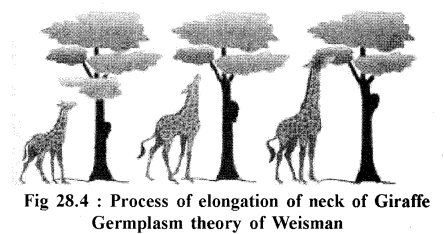
Darwinism :
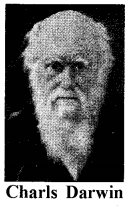
(A) General
Charls Darwin (1809 to 1882) was an English naturalist. He made world tour on a British fighter ship, “Beagle”. He collected various animals from different islands & countries. He studied Finches birds on Galopagos island of South America. These birds are now called as Darwin,s Finches.
A. R. Wallace (1823 to 1913) simultaneous to Darwin, but separately published view s similar to the Darwin. In 1858, the views of both Darwin & Wallace were published in a joint paper which were based on the views of Malthus.
In 1859, Darwin published a book “Origin of species by natural selection. Darwinism is also called as “Theory of natural selection”.
(B) Six fundamental propositions of Darwinism.
- Enormous fertility or over production in organisms. All animals & plants have an tendency of over production.
Examples –
A rabbit reproduces 3 to 4 times in a year and each time gives birth to 4 to 6 young ones. An oyster lays about 6 crore eggs in a year. Similarly, an ascaris lays about 2.5 crore eggs in a life spawn. If the entire progeny survives and multiplies, it will be eight times the size of the earth in a year.
Elephant is a slowest breeder, matures at the age of 30 years. it’s life spawn is of 100 years and a single female gives birth to six young ones in its life spawn. It is calculated that in 750 years a single pair of elephant give rise to 1.9 crore of elephants. Thus all animals multiply in geometrical ratio but still their number is maintained at a constant level. - Struggle for existence
Irrespective of over production, the animal population is maintained at constant level. Because the food & space are limited which results in struggle for existence. The struggle for existence is of three types-
(a) Intra specific struggle
(b) Inter specific struggle
(c) Extra specific struggle
The animals which are not successful in the struggle, do not survive. - Variation & Heredity
Variations occur commonly in the organisms and no two individuals are alike. The fittest which survive have advantageous variations.
Variations give rise to new characters and heredity passes them on to the next generation.
There are three sets of contrasting variations-
(a) Meristic and substantive variations
(b) Continuous and discontinuous variations
(c) Somatic and blastogenic variations - Survival of the fittest or Natural selection
In the struggle for existence only for existence only those individuals survive which are fitted biologically to the new conditions, as they possess advantageous variations. The animals which are unfit get perished Darwin called it “Natural selection “ and the Spancer termed it “ survival of fittest”. - Adaptation to the environment
Environment of any region is never constant. The environment changes are in food supply, climatic conditions (temperature, lightning, drought, food) and geographical conditions. The variations which best suited in a given
environment may prove unfavorable in the changed environment. Therefore, in order to survive an organism must be capable of changing in response to the changing environment.
For example in Mesozoic era, the environment was suitable for the dinosaurs, They ruled the Earth & occupied land, water and air. But later on in the Mesozoic are glaciations led to changes in the temperature and the vegetation became rare. In these conditions, the dinosaurs could not cope with the environment & soon became extinct. - Origin of new species
In the due course of time, the fittest are automatically selected. They survived & adapted to the natural environment. The adaptations of the survivors may result in the formation of new structures which are called as variations. The useful and favorable variations were transmitted from generation to generations and led to the formation of new species.
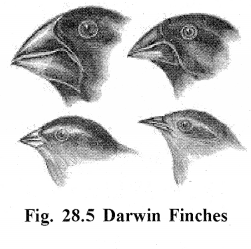
(C) Criticism of Darwinism
Initially, Darwinism was accepted enthusiastically, but later several objections were pointed by the scientists which are as follows-
- It describes the survival of fittest but not the “origin of fittes”
- It’s natural selection does not explain the presence of the connection links.
- It’s natural selection fails to explain super specialization of some organ, as a result some species get extincted.
- Darwin was ignorant about heritable & non-heritable variations. It is called as agnostic period of Darwinism.
- Darwin described micro variations in the evolution, but he failed to explain the initial origin of an organ.
- Darwinism failed to explain variations found in somatic & germ cells.
- Darwinism fails to explain the presence of vestigial organs.
- Darwinism failed to explain that in man sometimes most unfit but luckiest are protected and the fittest are handicapped.
It fails to explain toe origin of terrestrial animals from, the aquatic animals. - Darwinism failed to explain that how the characters are acquired & modified.
(D) Neo-Darwinism
In the beginning of 20th century, Darwinism had been modified on the basis of modem discoveries which is now called as New-Darwinism.
Neo-Darwinism was strongly supported by Wallace, Davenport, Waldane etc
New-Darwinism includes following 5 series-
- Gene mutation
- Changes in the number of structure of chromosomes
- Genetic re combinations
- Natural selection &
- Reproductive isolation
(1) Gene mutations
Change in the number of sequence of nucleotides in the DNA of gene is called as gene mutation.
Most of the mutations are detrimental but few may be beneficial .
The gene mutations are caused due changes in the environment. There is no specific rate of mutations Normally, gene seldomly mutates but the large number of genes & large number of organisms provide sufficient chances of variations.
(2) Changes in the structure & number of chromosomes
Changes in the configuration & number of nucleotides & genes led to changes in the structure of the chromosome. These change are caused as a result of delition, duplication, translocation & inversion.
Changes in the structure of the chromosomes causes variations in the animals which finally led to origin of species.
(3) Genetic recombination
Game to genesis involves meiosis in which crossing over results in the development of new genetic re combinations. As a result variation are generated in the organisms.
(4) Natural selection
Natural selection facilitates beneficial gene recombination’s to flow into the off springs.
(5) Reproduction isolation
When the different populations of a species get isolated by the barriers, after some times they fail to interbreed. It is due to the acclimated changes appeared in the gene structure as a result of mutations, chromosomal aberrations & polyploidy. These changes lead to the variations, as result the populations evolved into a new species.
Geographical barriers like mountains, sea, rivers etc and physiological barriers prevent intraspecies reproduction
The species which are developed as a result of geographical barriers are called as allopatric species. The species which are developed as result of reproductive (physiological) isolation in the same geographical environment are called as sympatric species.
Question 3.
Interperte Darwininsm & Neo Darwinism.
Answer :
Darwinism :

(A) General
Charls Darwin (1809 to 1882) was an English naturalist. He made world tour on a British fighter ship, “Beagle”. He collected various animals from different islands & countries. He studied Finches birds on Galopagos island of South America. These birds are now called as Darwin,s Finches.
A. R. Wallace (1823 to 1913) simultaneous to Darwin, but separately published view s similar to the Darwin. In 1858, the views of both Darwin & Wallace were published in a joint paper which were based on the views of Malthus.
In 1859, Darwin published a book “Origin of species by natural selection. Darwinism is also called as “Theory of natural selection”.
(B) Six fundamental propositions of Darwinism.
- Enormous fertility or over production in organisms. All animals & plants have an tendency of over production.
Examples –
A rabbit reproduces 3 to 4 times in a year and each time gives birth to 4 to 6 young ones. An oyster lays about 6 crore eggs in a year. Similarly, an ascaris lays about 2.5 crore eggs in a life spawn. If the entire progeny survives and multiplies, it will be eight times the size of the earth in a year.
Elephant is a slowest breeder, matures at the age of 30 years. it’s life spawn is of 100 years and a single female gives birth to six young ones in its life spawn. It is calculated that in 750 years a single pair of elephant give rise to 1.9 crore of elephants. Thus all animals multiply in geometrical ratio but still their number is maintained at a constant level. - Struggle for existence
Irrespective of over production, the animal population is maintained at constant level. Because the food & space are limited which results in struggle for existence. The struggle for existence is of three types-
(a) Intra specific struggle
(b) Inter specific struggle
(c) Extra specific struggle
The animals which are not successful in the struggle, do not survive. - Variation & Heredity
Variations occur commonly in the organisms and no two individuals are alike. The fittest which survive have advantageous variations.
Variations give rise to new characters and heredity passes them on to the next generation.
There are three sets of contrasting variations-
(a) Meristic and substantive variations
(b) Continuous and discontinuous variations
(c) Somatic and blastogenic variations - Survival of the fittest or Natural selection
In the struggle for existence only for existence only those individuals survive which are fitted biologically to the new conditions, as they possess advantageous variations. The animals which are unfit get perished Darwin called it “Natural selection “ and the Spancer termed it “ survival of fittest”. - Adaptation to the environment
Environment of any region is never constant. The environment changes are in food supply, climatic conditions (temperature, lightning, drought, food) and geographical conditions. The variations which best suited in a given
environment may prove unfavorable in the changed environment. Therefore, in order to survive an organism must be capable of changing in response to the changing environment.
For example in Mesozoic era, the environment was suitable for the dinosaurs, They ruled the Earth & occupied land, water and air. But later on in the Mesozoic are glaciations led to changes in the temperature and the vegetation became rare. In these conditions, the dinosaurs could not cope with the environment & soon became extinct. - Origin of new species
In the due course of time, the fittest are automatically selected. They survived & adapted to the natural environment. The adaptations of the survivors may result in the formation of new structures which are called as variations. The useful and favorable variations were transmitted from generation to generations and led to the formation of new species.

(C) Criticism of Darwinism
Initially, Darwinism was accepted enthusiastically, but later several objections were pointed by the scientists which are as follows-
- It describes the survival of fittest but not the “origin of fittes”
- It’s natural selection does not explain the presence of the connection links.
- It’s natural selection fails to explain super specialization of some organ, as a result some species get extincted.
- Darwin was ignorant about heritable & non-heritable variations. It is called as agnostic period of Darwinism.
- Darwin described micro variations in the evolution, but he failed to explain the initial origin of an organ.
- Darwinism failed to explain variations found in somatic & germ cells.
- Darwinism fails to explain the presence of vestigial organs.
- Darwinism failed to explain that in man sometimes most unfit but luckiest are protected and the fittest are handicapped.
It fails to explain toe origin of terrestrial animals from, the aquatic animals. - Darwinism failed to explain that how the characters are acquired & modified.
(D) Neo-Darwinism
In the beginning of 20th century, Darwinism had been modified on the basis of modem discoveries which is now called as New-Darwinism.
Neo-Darwinism was strongly supported by Wallace, Davenport, Waldane etc
New-Darwinism includes following 5 series-
- Gene mutation
- Changes in the number of structure of chromosomes
- Genetic re combinations
- Natural selection &
- Reproductive isolation
(1) Gene mutations
Change in the number of sequence of nucleotides in the DNA of gene is called as gene mutation.
Most of the mutations are detrimental but few may be beneficial .
The gene mutations are caused due changes in the environment. There is no specific rate of mutations Normally, gene seldomly mutates but the large number of genes & large number of organisms provide sufficient chances of variations.
(2) Changes in the structure & number of chromosomes
Changes in the configuration & number of nucleotides & genes led to changes in the structure of the chromosome. These change are caused as a result of delition, duplication, translocation & inversion.
Changes in the structure of the chromosomes causes variations in the animals which finally led to origin of species.
(3) Genetic recombination
Game to genesis involves meiosis in which crossing over results in the development of new genetic re combinations. As a result variation are generated in the organisms.
(4) Natural selection
Natural selection facilitates beneficial gene recombination’s to flow into the off springs.
(5) Reproduction isolation
When the different populations of a species get isolated by the barriers, after some times they fail to interbreed. It is due to the acclimated changes appeared in the gene structure as a result of mutations, chromosomal aberrations & polyploidy. These changes lead to the variations, as result the populations evolved into a new species.
Geographical barriers like mountains, sea, rivers etc and physiological barriers prevent intraspecies reproduction
The species which are developed as a result of geographical barriers are called as allopatric species. The species which are developed as result of reproductive (physiological) isolation in the same geographical environment are called as sympatric species.
Question 4.
Explain theory of Mutation.
Answer :
Theory of mutation (de Vries Theory )
A Dutch botanist Hugo de Vries (1848 – 1935) while working on evening primrose (Oenothera lamackiana) observed that suddenly some plants develop different characters. These variation get inherited into the next generation and result in the formation of new species
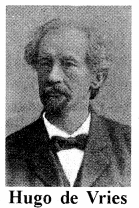
He introduced the term mutation for these suddenly appearing variations. He postulated mutation theory which was published in his two volume publication (1900-1903). He explained that these mutations are responsible for evolution, specially the origin of species. The variations in the members of a species is because of these constantly occurring mutations
The mutation theory of de Vries can be explained as follows-
- The natural breeding species suddenly develop changes which are called as mutation.
- Mutation are heritable and form new species
- The members with the symptoms of mutation are called as mutant.
- All the species have tendency of mutations that can be less or more.
- The mutations may be useful or harmful.
- The mutations are influenced by natural reelection. The useful mutations survive whereas the harmful are rejected by natural reelection
- The new species are not formed by slow natural selection but it occurs sudden.
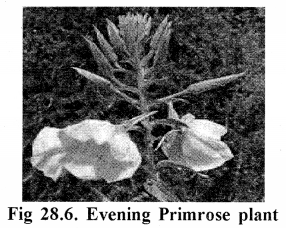
Criticism of mutation theory :
- Mutations in the evening primrose is a chance and they can’t be in other organisms .
- The variations in the evening primrose seen by de Vries were not due to mutations but they were because of irregular isolation and conjugation.
- This theory failed to explain isolation and discontinuity among organism.
- It is unable to explain evolution through connecting links.
- Mutation is not the basis of evolution
Question 5.
What to you mean by variations. Explain their reasons and their role in evolution.
Answer :
Variations :
No two animals on the earth are exactly similar. Even the members of one species show differences and the generation of similar parent are also show differences. The differences in the characters of the animals of same species is termed as Variation. The variations are the main & progressive factors for evolution.
Causes of Variations :
There are many factors which cause variations in the animals. The main factors are as follows-
- Environment
It affects the organisms directly - Inherent tendency
The organisms have an inherent tendency to vary. Hence, under no circumstance, the two organisms can be exactly alike. - Endocrine glands
Abnormal secretions of hormones from the endocrine glands are able to cause somatic & germinal variations - Dual parentage
Bi parental parentage is the real cause of variation (Weismann). An organism receives ½ germplasm from its parents, ¼ from grand parents. 1/8 from grand-grand-parents & so on.
Type of variations :
(A) Somatic & germinal variations
The somatic variations are caused due to environmental effects. They are not heritable hence are lost with the death of the organism. They are also called as acquired variations.
Examples :
- More developed muscles in athletes.
- Mental development through education.
- Loss of body organ in an accident.
- Small feet of Chinese ladies.
- Sun-burnt skin in Europeans living in tropical regions.
The Germinal variations occur in the germplasm of the organisms. The germplasm is used in the formation of the gametes, hence, these variations transmit from generation to generation.
Sometimes somatic variations after repeated generations produce germinal variation effect.
Examples-
- Body length
- Colour of hair
- Colour of eye pupil
(B) Determinate and Indeterminate variations
The variations that occur controlled & in the definite direction of adaptation by unknown factor are called as determinate variations
The variations that are governed by some unknown force and imposed to occur in one line or certain lines, usually in an adaptive direction, Examples -overgrowth antlers of Iris deer & Tusks of Jefferson mammoth.
The variations which are not governed by any law but take place in some imaginary direction of change are called as indeterminate variations. The theory of natural selection of Darwin is based on this variation.
(C) Continuous & discontinuous variations.
They are also called as positive & negative variations. Darwin called discontinuous variations as fluctuating variation, because they fluctuate on either side of the average condition. Progressive accumulation of these fluctuations in one direction lead to the formation of new species.
Discontinuous variations are sudden & large and appear as totally new. They are also as mutations. They are mostly stable & heritable.
A few examples of discontinuous variations are absence of tail in kittens, absence of horns in calf, 6 fingers in man, absence of spines in the rose etc.
(D) Meristic & substantive variations
Repetition in the number of parts of a organism is called as meristic or quantitative variations.
Examples
- Presence of 6 arms in place of 5 in star fish.
- Presence of 13 ribs in place of 12 in man.
- Presence of 6 fingers in place of 5 in man.
- Absence of one kidney or one lung in man
Variation in form, size, shape & color of any organism or its parts is called as substantive or qualitative variations.
Examples
- Hair color
- Eye color
- Shape of nose, ear & eye
- Height of plant etc.
Significance of variations-
- Variations are the main factor of evolution
- Variations help organisms in adaptation.
| Differences between continuous and discontinuous variations | ||
| Characters | Continuous variation | Discontinuous variation |
| Presence | Commonly found in all animals | They occur suddenly |
| Other name | Fluctuation | Salutation |
| Cause | Crossing over during gamete formation | Change in the gene or genome |
Question 6.
What is origin of species ? Explain the main factors of origin of species.
Answer :
Formation of new species from an ancestral species is called as speciation. When the number of animals get increased in a habitat, they migrate to new habitats. They get divided into small groups and develop reproductions isolation. Such animals either lost or get adapted by developing variations. Gradually, the gene pool become different than the ancestral species and lead to the formation of new species. The speciation is of two types
(A) Allopatric speciation :
It occurs when members of a species behave their own habitat and migrate to distantly situated new habitats. Gradually, there gene pool is changed because of new habitat and they develop

distinctly new characteristics and lead to the formation of new species. It is also called as geographical speciation. Example: Darwin Finches.
(B) Sympatric speciation :
When a new species evolved from a single ancestral species while inhabiting the same geographic region.
Sometimes two genetically variable animals or animals from different habitat may interbreed to form an new species. This process occurs between the animals of different species. It is called as hybridization and resulting offspring is called
hybrid. The main factors of speciation are as follows :
- Mutation
- Genetic drift
- Migration
- Natural selection
- Sexual-Recombination
- Hybridization
- Isolation
Question 7.
Explain, how isolation help in evolution ?
Answer :
Segregation of the population of a species into small units or strains or subspecies so that they become unable to interbreed is termed as isolation. They sub units become unable to breed with the ancestral species and lead to the formation of new species. This isolation is due to some physical or geographical or other barrier.
Wagner explained the significance of isolation. Metcalf stated that the factors that prevent interbreeding and isolate into small groups are called as isolation factors. According to Kellog isolation is a biological catalyst that facilitate changes among the animals.
The Darwin finches found in Galapagos island are the result of isolation.
Types of Isolation-
(A) Geographical isolation:
Geographical barriers play an important role in the process of speciation. Such as Oceans, Sea, Desert, Dense forest, Mountains and Hills etc. The animals become unable to cross such barriers and fail to interbreed. Every group adapt itself by developing changes. Example: Darwin finches.
(B) Spacial Isolation:
In this type of isolation, there is no geographical barrier in between the animal groups but because of long distances the animal groups become unable to interbreed. For example one species of elephant seal inhabit South pole and second species inhabit North America. The big distance between two keep them isolated.
(C) Reproduction Isolation:
Many animals are biologically deficit and are unable to reproduce. It is called as reproductive or biological isolation. It is of two types
(a) Pre-zygotic Isolation
The animals are unable to form zygotes due to some biological abnormalities It is of following types-
- Habitat or Ecological Isolation
The animals are unable to breed due to different habitat or ecological conditions. - Seasonal Isolation – Animals living in the same habitat get unable to breed but to difference in the breeding season.
- Morphological Isolation – Animals become unable to breed due to difference in the shape.
- Physiological Isolation – The reproductive organs & their physiology is species specific. Hence, the animals of different species are unable to breed though they live in same habitat.
(b) Post-zygotic Isolation
Sometimes, the animals of different species may breed but their zygote fails to develop further and normally dies. It is called as zygotic mortality. Sometime, such zygote develop to form hybrid but such hybrid either die or become sterile, For example, the Horse & Donkey interbreed to produce sterile Mule.
Significance of Isolation:
On the earth, origin of new species is the result of evolution and the isolation play impotent role in this process. The isolation prevent interbreeding & help in natural selection. The isolation also prevent the transmission of useless & harmful genes into the animals.